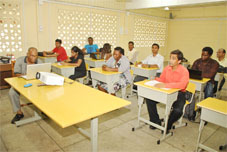Relatively low cost of living and favourable weather conditions position Guyana as one of the ideal destinations for offshore siting of international universities, Chief Executive Officer and Executive Vice President of Texila American University Saju Bhaskar told Stabroek Business in an interview earlier this week.
Texila has completed its first year in Guyana, providing training for 50 international students and 25 Guyanese in medicine and dentistry.
Bhaskar told Stabroek Business that Guyana’s low cost of living allows the university to offer international students tuition fees of US$7,500 annually, which is highly competitive, compared with universities offering similar courses in developed countries. The university offers Guyanese students tuition at 50 per cent of that cost. The institution, which is currently headquartered at the Critchlow Labour College, also offers two scholarships annually.

According to the CEO, overseas-based students undergoing studies here are likely to spend around US$10,000 annually in the local economy. “We expect to have around 3,000 students here within the next five years which means that they will be spending around US$30 million here,” Bhaskar said.
Students currently undergoing training at the Texila campus here are nationals of several countries including Nigeria, Kenya, Zambia, Botswana, India and the United Kingdom.
Texila currently has an agreement with the Georgetown Public Hospital Corpora-tion under which it pays the institution to utilize its facilities for training students. Additionally, Bhaskar told Stabroek Business, local state-run medical institutions will also benefit from the services of its students who undergo attachments at those institutions.
Bhaskar said that while several Caribbean countries including St Kitts, St Vincent and the Grenadines and St Lucia had benefited significantly from the presence of international universities, “Guyana has had less than its fair share of international universities.” However, according to the university’s senior executive, developments in the country meant that Guyana was becoming a more recognizable destination for such institutions.
The university’s official brochure indicates that its 5.5 years Doctor of Medicine Programme is designed for students from high school and non-pre-medical backgrounds. The programme is divided into three parts, a 16-month pre-medical programme, a 20-month pre-clinical programme and an 80-week clinical programme.
The university’s four-year Doctor of Medicine Programme is designed to work closely with highly competent students with the first two years of the programme focusing on basic sciences and their application to clinical medicine. Students who are successful in their pre-clinical courses will have the opportunity of doing their clinical work at various universities in the USA.
Bhaskar told Stabroek Business that the university had been facilitated by the Guyana Office for Investment to import equipment for the setting up of its laboratory. Additionally, he said, the university was contemplating the setting up of a low-cost or free clinic to serve the Guyanese public while facilitating the training of its students.




